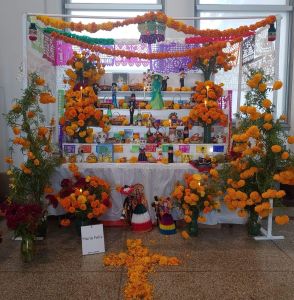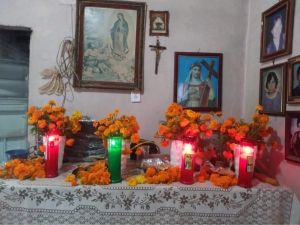A lot of people imagine the Day of the Dead in the form of the aesthetic pictures they see online or in movies like Coco, but few Americans seem to fully understand the cultural meaning behind this Mexican tradition. It’s a celebration and honoring of our loved ones who have passed on, but there’s far more to the experience than just the pretty flowers and colorful decorations everyone recognizes.

taken by Maria F. Rosas
Along with just being poorly informed, many people are actually misled based on stereotypes or bad sources, causing a lot of misinformation. I decided to ask three of my friends some questions that helped me see what facts are commonly known, as well as which are mostly left out of the discussion for those who don’t practice the culture firsthand.
One of the biggest misconceptions is that the Day of the Dead, known as Día de los Muertos in Spanish, is a single day. In fact, the celebration is spread out from October 31st to November 2nd, with each day having a specific group honored. The first day is for those who pass of natural causes or old age, the second is for children and the third is for those who had their lives taken from them.
A friend named Arundhati Kennedy, recalled it being around two or three days. But like most, she didn’t know the days had their own meanings or what they were. Another friend named Tayler Stukey said, “I know it’s three days because of Spanish class but I don’t remember if there was some kind of reason behind it” and explained that the holiday name was misleading and might have caused much of this specific misconception.
Because most of the stereotypical focus is on the aesthetics and visuals, it feels like most non-practitioners don’t know anything about what actually celebrating is like as an experience. Many believe the holiday must be somber, depressing or mourning the dead ritually, but in reality, it’s more like many small traditions that are completed over the days to remember, honor, reconnect with and appreciate loved ones who have passed on.

photo take by Maria F. Rosas
These traditions are also important to spiritual beliefs that the dead are very much still with us in another sense, and can be guided and comforted. Because of its passionate spiritual roots, preparations for this holiday can begin days, weeks, or even months prior to October 31st. Traditionally in the small towns of Mexico, long trails of marigold petals can be seen leading from the cemetery’s tomb to the home of the family of the deceased, guiding the spirits of the loved ones home to visit.
Unfortunately for those who live farther away or in different towns, they must substitute trailing petals from the altar to the end of their property or up to the front door. Another misconception may be that the celebrations are personal to the family and held privately. The Day of the Dead may come off as a very private and personal family or solitary holiday filled with sadness, but in many ways, it’s a community event that brings families together.
The whole celebration begins with the constant ringing of the town’s church bell as a greeting to the spirits. This bell is rung for the entire three days of the return, manned by around 15 boys who will stay there day and night to ensure the bell never goes silent. Not only is this something the boys work hard to provide the community, but it’s paid back as the townspeople feed the boys when they come asking. In larger areas, like Mexico City, and in some towns that choose to, there may be parties with fireworks, music and parades.
Since Day of the Dead has so many popular misconceptions, I wanted to find out what people know about the altars created to honor the holiday. Lauren Swint said things that were “specially prepared for the souls,” meaning things like hot chocolate, dried fruit and marigolds. She believed the reason was because “altars make the souls feel welcomed and show them they haven’t been forgotten.”
Most of the items on these altars are favorites of relatives that are prepared specifically for their return, such as foods brought out in baskets and glasses of said person’s favorite alcohol or a mug of fresh hot chocolate. Families take their time to make tamales to leave on altars along with mole and other food items, as well as marigolds.

photo taken by Isaias Rosas
There are also items prepared specifically for the Day of the Dead celebration. There is a specific bread known as “pan de muertos,” or bread of the dead sold everywhere made for this specific event. Depending on where you live in Mexico and especially for families celebrating it here in the States, the type of bread used as pan de muertos can change from family to family. Candles are placed on relatives tombstones, as well as on family altars, as a way to help relatives find their way back home in the darkness.
There is always more to learn when it comes to the Day of the Dead. The problem is that Day of the Dead isn’t known for the traditions and meanings behind it, because most people only see the themes and decorations. Remember that beyond the food and colorful altars, there’s a meaning behind everything that’s done.
Losing someone is difficult, but this celebration of both death and life helps remind us that someone who’s passed is never truly gone. They will always live in our hearts and memories for years to come.



